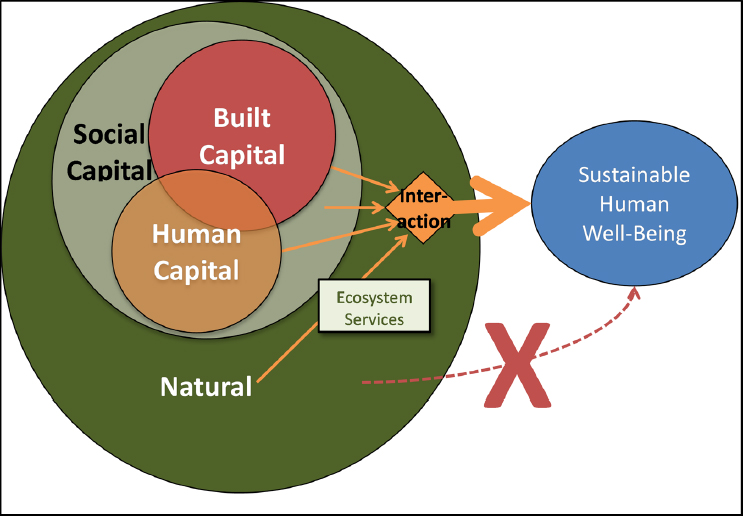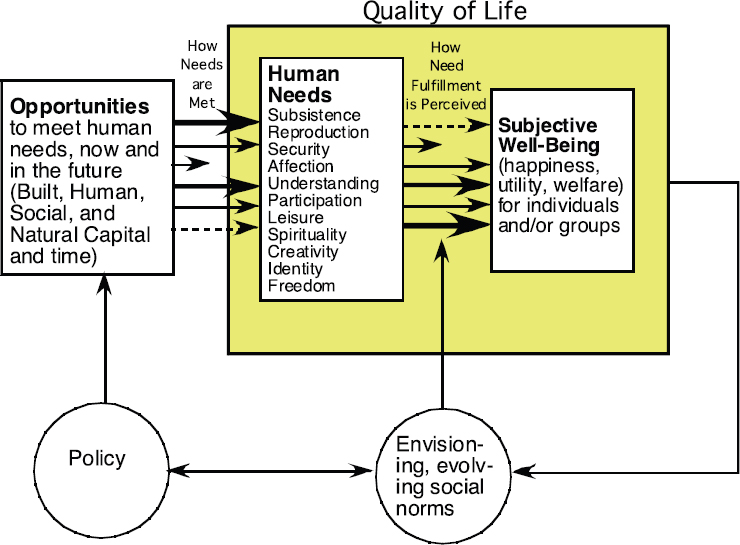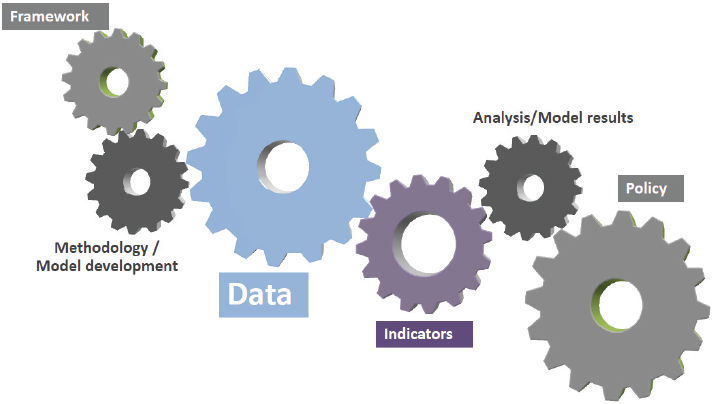7
Paths Forward
Steve Skerlos, Arthur F. Thurnau Professor of Mechanical Engineering and Civil and Environmental Engineering; co-director, Center for Socially Engaged Design; and director, Sustainability Education Programs at the University of Michigan, reflected on observations of paths forward for sustainability. Sustainability has roots in the environment, but it is more widely recognized now that it is about people. There is a lot of data available for sustainability-related analysis, but it is not enough. There are more integrated models as well, but there are also large gaps between building models and model-driven decision making, partly due to concerns with validating them.
It is widely recognized that recent decisions have created situations that will become challenges in the future, such as increasing carbon dioxide emissions; thus, there is a greater appreciation for interlinked systems, codesign, decision lock-ins, and path dependencies as they relate to sustainability. Education grew but also new knowledge is being gained by moving beyond disciplines—transdisciplinarity is gaining appreciation. Education is a clear imperative at all levels and in every direction, including participatory design. Sustainability actions and claims abound in industry, but they need to be better grounded in sustainability science.
Dr. Skerlos also noted that, looking forward, sustainability is at a stage equivalent to gross measures for human health, such as pulse or blood pressure. The science has not progressed to a point to be able to provide clear metrics or practices for improvement, such as in minutes of exercise, cholesterol targets, and diet for human health. Aiming for human well-being is a notable goal, but it does not yet translate into information usable by an engineer for designing a car. Sustainability engineering is one path forward, which would translate insights from modeling into needed action at national, city, and industrial levels. This application to industry would hold technology innovations to necessary standards. There is a challenge in finding common goals, such as well-being, because of differences in value systems. It may be easier to agree on what should not happen instead of what should happen. For example, not damaging the biosphere (e.g., ocean acidification) may be an easier goal to establish targets for than trying to agree to a vision of well-being.
This perspective is more similar to a perspective of decision making from engineering and design perspectives, indicated Dr. Skerlos, and allows for multiple design problems to be analyzed simultaneously to see where solutions to such problems conflict with each other. The world would then be viewed not as multiobjective, but as a series of interlinked objectives with ecosystem and social constraints (e.g., pH constraints for seawater). The development of metrics would be needed that help in better understanding progress relative to such constraints. This design perspective is useful to the sustainability science community for moving forward with clarity and when interfacing with specific sectors viewed as the cause of certain problems.
Robert Costanza, professor and chair of public policy at the Australian National University’s Crawford School of Public Policy, focused his discussion beyond oceans to future challenges of integrating metrics, models, and the vision to transition toward sustainability. He touched on the concept of planetary boundaries and the constraints of an ecological life support system, emphasizing the need for new framing approaches to drive behavior change. Sustainable solutions for these complex problems require the combination of three elements: the development of a new shared vision of sustainability that integrates a range of different disciplines, including not only ecology and economics but also psychology, history, sociology, and anthropology; new analytical tools and techniques that focus on systems thinking; and behavior change through new implementation instruments and “therapies,” such as societal therapy.
To construct a new shared vision of sustainability, Dr. Costanza asked, “What does a desirable system look like? How does society prosper within global constraints while producing the elements of well-being and quality of life?” He described the Sustainable Development Goals (SDGs) as significant in bringing together a range of inclusive goals and objectives, but these goals operate in silos. Dr. Costanza called for integration across goals that recognizes the synergies, trade-offs, and interdependencies of the underlying system. The pursuit of an overarching goal may include prosperity and a high quality of life that is both equitably shared and sustainable. Ecological economics provides an example of a transdisciplinary field that attempts to combine these elements into a systems perspective to achieve efficient allocation and fair distribution within the confines of planetary boundaries. Sustainability entails dealing with basic assets. Dr. Costanza presented a refined version of William Clark’s social-environmental system model that captures the interactions between four of Dr. Clark’s five capital assets: natural, social, built, and human capitals (Figure 7-1). The natural environment and natural capital provide the overarching system, while built, human, and social capitals interact to produce sustainable well-being.1,2
Dr. Costanza suggested not using the maximization of gross domestic product (GDP) as an indicator of well-being and quality of life. To develop appropriate metrics and analytical tools for sustainable well-being, research agendas need to ask questions about how to define and effectively measure a desirable quality of life and well-being. Dr. Costanza outlined recent research on this concept by presenting a diagram with a list of basic human needs that go well beyond subsistence and reproduction for achieving well-being, including security, affection, and participation (Figure 7-2). The list of fundamental human needs had several variations depending on culture, individual, and other factors. From a policy perspective, the objective is to create opportunities for people to meet those needs through varying configurations of built, social, human, and natural capital assets. Positive psychology provides another approach to quality of life by looking beyond income and associating a sense of well-being with positive emotion, engagement, good relationships, meaning and purpose, and accomplishment.
A number of alternative metrics to GDP of national welfare and well-being have been put forward in recent years, including the World Values Survey and Bhutan’s Gross National Happiness Survey. Dr. Costanza, however, indicated that these metrics still have flaws, and there remains a need for additional research to develop hybrid, integrated indicators linked to the SDGs. He points to the Genuine Progress Index (GPI) as an example. The GPI adds several elements to the popular GDP metric, including social, human, and natural capital, while subtracting undesirable elements, such as crime or automobile accidents. One analysis that collected national level GPI studies for 17 countries to construct a representative global GPI per capita found that the global GPI per capita rate plateaued while the global GDP per capita rate increased. This result, while not a perfect indicator, reveals the inadequacy of using GDP as an indicator of well-being and the need for the creation of a new quality-of-life approach that builds on the values of a broad group of stakeholders. Several states, such as Maryland and Vermont, made efforts to adopt new well-being approaches, using their own versions of the GPI.
In addition to rethinking the GDP metric, Dr. Costanza advocated for convening natural and social scientists from different fields to collaborate and integrate the modeling of societies to address large questions such as whether transitions to sustainability can occur without major collapses of civilization. Future Earth exemplifies this type of project by bringing together historians, ecologists, and anthropologists to help understand how humanity has evolved.
___________________
1 Costanza, R., et al. 2014. Changes in the global value of ecosystem services. Global Environmental Change 26:152–158.
2 Matson, P., W. C. Clark, and K. Andersson. 2016. Pursuing Sustainability: A Guide to the Science and Practice. Princeton, NJ: Princeton University Press.

SOURCE: Robert Costanza, Presentation, National Academies of Sciences, Engineering, and Medicine Workshop, January 14, 2016, Newport Beach, California.

SOURCE: Robert Costanza, Presentation, National Academies of Sciences, Engineering, and Medicine Workshop, January 14, 2016, Newport Beach, California.
Such work would provide important research and insights going forward. A number of countries and institutions, such as New Zealand and Australia, developed methods that strive for this inclusiveness, because they believe the public can add significant value in developing a new shared vision of sustainability. New Zealand conducted a study that asked the public about their opinion on the current system and its future. Australia recently released a similar scenario planning survey that focused on four possible “futures” for the system. The public trust doctrine provides another approach, which implies that governments have a financial responsibility to respect the commons, thus bringing new elements of legal principles and property rights into the sustainability transition. Finally, Dr. Costanza noted the need for new communication venues to relay these results and solutions in the transition to a more sustainable world.
William Clark, Harvey Brooks Professor of International Science, Public Policy and Human Development at Harvard University, provided insights on paths forward for sustainability science. Policy decisions result from preceding actions and can be illustrated as mechanical gears (Figure 7-3); however, missing from the analogy of mechanical gears is the concept of linkages among data, models, and indicators, which should not be developed independently. Similarly, monitoring needs to be done in connection with experiments, theory, and policy needs. These efforts need to be done in the context of a sustainability framework focused on people, equity, and long-term thinking, he said.
The report committee for Our Common Journey used a framework with an anthropocentric view. For example, in such a framework it was determined that whales matter because voters determined that whales were worth protecting. Such values for protection of natural elements of the world (e.g., whales, trees) are incorporated into this framework. This framework, he said, provides an end (i.e., targets, goals) that the means can use to try to accomplish (i.e., capital asset stocks, production-consumption systems).
Dr. Clark said that the means of achieving well-being over the long run is done with (capital) asset management so that resources are not depleted leaving future generations with less than there was before (see Figure 1-2). Models and frameworks of sustainability need to represent such assets, and the factors that result in change with time need to be determined in order to assess its effect on well-being. Not every model needs to be integrated completely; variables can be held constant by making approximation and evaluating changes when you adjust the scenario for a given variable. This provides a conceptual modeling framework. Dr. Clark also said another

SOURCE: Prabhu Phigali, Presentation, National Academies of Sciences, Engineering, and Medicine, January 15, 2016. Newport Beach, California. Adapted by William Clark, for presentation, National Academies of Sciences, Engineering, and Medicine, January 15, 2016. Newport Beach, California.
component of frameworks needed is understanding how people organize activities to cultivate assets and generate well-being (i.e., production-consumption systems). For example, people organize to use land, plant crops, work soil with a tool from manufactured capital, all within the context of a world trade system. There are many different production and consumption systems. Additionally, it needs to be recognized that governments and large industry need to be treated explicitly in a framework because they are main actors in a production and consumption system. They are drivers behind the mechanical wheels in the gear system analogy.
To determine progress toward sustainable development, Dr. Clark said, it is necessary to track all asset stocks from whichever framework is being utilized—meaning all of the variables and indicators that are subsumed under the framework. Then it can be determined if the production-consumption system is working the way it should. Additional indicators are needed for social learning and adaptive management. Data is needed so that models will reflect reality and not imagination. Spillover impacts to other spaces need to be tracked. For example, researchers need to understand how one location does because its pollution was shipped elsewhere. This addresses the challenge of understanding externalities.
There remains a large gap in treating models as though that is how scientists provide advice to decision makers. Models are one component of expert advice, and often inform the expert, who in turn informs the decision maker. More work is needed to understand how models best serve decision makers and fit within systems where scholarly experts are integrating their work with practitioners and stakeholders. Dr. Clark said that social environmental systems are complex adaptive systems, which are not easy to model in order to make projections, and so there are questions about how to deal with innovation, adaptation, and emerging value systems.
Dr. Clark concluded by saying there is a need for community building. In the early days of the Global Change Research Program, there were biogeochemists interacting with physical climatologists and ecosystem ecologists, but there were differences in language and little understanding of the other scientists’ fields. There were efforts to increase cross-discipline learning, where scientists would learn about the current state of understanding, datasets, theories, and debates in the others’ fields. More efforts like this are needed to move sustainability science forward so that different disciplines truly understand other fields as they relate to sustainability. Publishing in a collective space is a large part of this community building, which is why success with the sustainability science section of the Proceedings of the National Academy of Sciences is important to continue. Another option for sharing ideas would be to have an online outlet where a small group of editors from different fields can select a paper published in their respective journals to share as an example of a finding they believe other sustainability scientists should know. That paper and a short abstract could then be posted to the online location. This would not be possible with researchers simply setting up search terms, but would require a small group of experts to nominate a select number of key papers to share.





